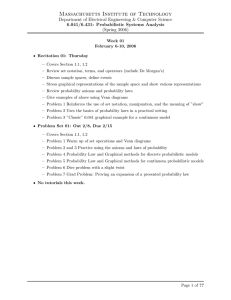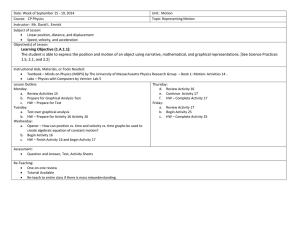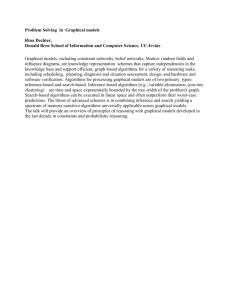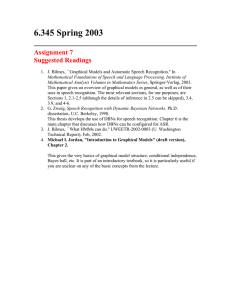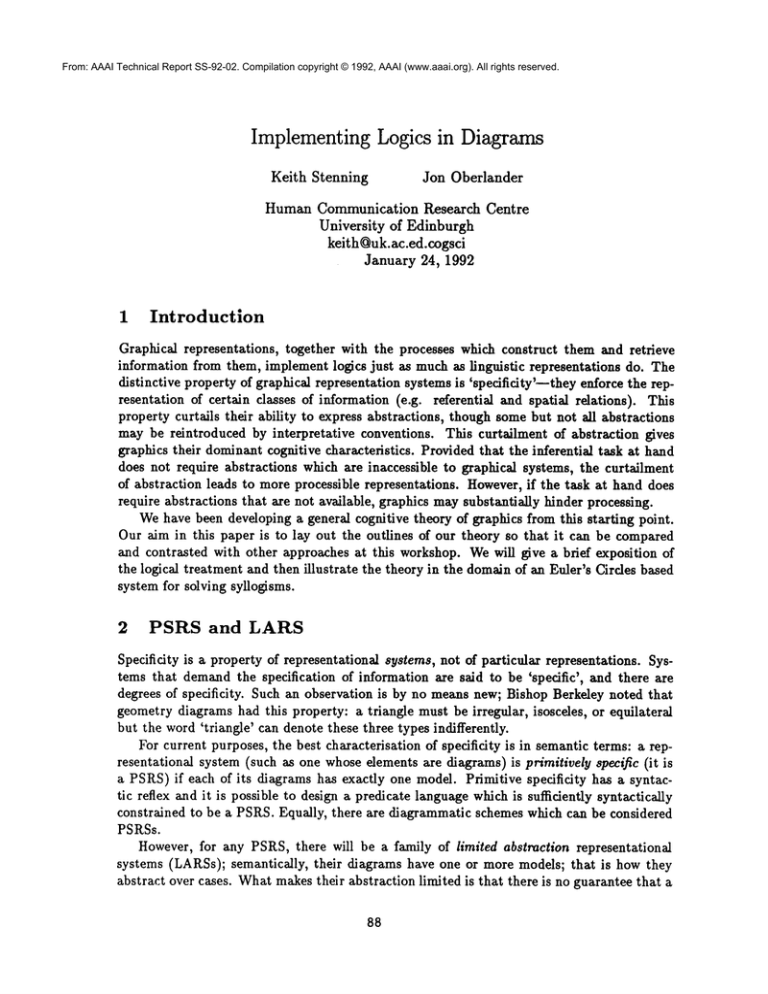
From: AAAI Technical Report SS-92-02. Compilation copyright © 1992, AAAI (www.aaai.org). All rights reserved.
Implementing Logics in Diagrams
Keith Stenning
Jon Oberlander
Human Communication Research Centre
University of Edinburgh
keith@uk.ac.ed.cogsci
January 24, 1992
1
Introduction
Graphical representations,
together with the processes which construct them and retrieve
information from them, implement logics just as much as linguistic representations do. The
distinctive property of graphical representation systems is ’specificity’--they enforce the representation of certain classes of information (e.g. referential and spatial relations). This
property curtails their ability to express abstractions, though some but not all abstractions
may be reintroduced by interpretative
conventions. This curtailment of abstraction gives
graphics their dominant cognitive characteristics. Provided that the inferential task at hand
does not require abstractions which are inaccessible to graphical systems, the curtailment
of abstraction leads to more processible representations. However, if the task at hand does
require abstractions that are not available, graphics maysubstantially hinder processing.
Wehave been developing a general cognitive theory of graphics from this starting point.
Our aim in this paper is to lay out the outlines of our theory so that it can be compared
and contrasted with other approaches at this workshop. Wewill give a brief exposition of
the logical treatment and then illustrate the theory in the domainof an Euler’s Circles based
system for solving syllogisms.
2
PSRS and
LARS
Specificity is a property of representational systems, not of particular representations. Systems that demandthe specification of information are said to be ’specific’, and there are
degrees of specificity. Such an observation is by no means new; Bishop Berkeley noted that
geometry diagrams had this property: a triangle must be irregular, isosceles, or equilateral
but the word ’triangle’ can denote these three types indifferently.
For current purposes, the best characterisation of specificity is in semantic terms: a representational system (such as one whoseelements are diagrams) is primitively specific (it is
a PSRS)if each of its diagrams has exactly one model. Primitive specificity has a syntactic reflex and it is possible to design a predicate language which is sufficiently syntactically
constrained to be a PSRS. Equally, there are diagrammatic schemes which can be considered
PSRSs.
However, for any PSRS, there will be a family of limited abstraction representational
systems (LARSs); semantically, their diagrams have one or more models; that is how they
abstract over cases. Whatmakestheir abstraction limited is that there is no guarantee that a
88
AllA areB
SomeA are B
SomeA are not B
0
~
NoAareB
Figure
1: Characteristic
diagrams
LARSwill have a single representation for an arbitrary set of models. The movefrom a PSRS
to a LARSalso has a syntactic reflex; for example, new predicate symbols can be introduced,
corresponding to disjunctive predicates.
Actual diagrammatic or graphical systems are almost always LARSsrather than PSRSs.
Elsewhere, we have investigated the tradeoffs between expressiveness and tractability involved
in the difference. The focus here is on howan actual diagrammatic reasoning system--Euler’s
Circles--can be used as a system abstractive enough to be expressive, but limited enough to
be efficient.
3
Euler’s
Circles
ECsare an interesting
domainforourpurposes
becausetheyexplicitly
implement
a logic
andthisrequires
theexpression
of a rangeof abstractions.
Therehasalsobeenconsiderable
argument
amongpsychologists
abouttheirrelation
to thementalrepresentations
people
use
for’doing
syllogisms’
without
external
aids.
Euler’s
Circles
(ECs)as traditionally
interpreted
by psychologists
havebeentakento
PSRS(seee.g.Erickson
1974,Guyotegz Sternberg
1981,Johnson-Laird
1983);
however,
it
possible
to re-interpret
themas LARSs,
andthisis howtheyhaveactually
beenusedin logic
teaching.
We beginby defining
a graphical
algorithm
forsolving
syllogisms
andthenexamine
its
relation
to ourgeneral
theory.
Thefoursyllogistic
premisses
mapmany-to-many
ontotheir
models.However,
eachhas a uniquemaximalmodel(seeFigure1). A shadingconvention
canbe usedto distinguish
regions
corresponding
to typeswhichmustbe present
in anymodel
of thestatement.
Sinceeachpremissnowhasa uniquediagram,
it remains
to specifyhow
to ’register’
twopremiss
diagrams
andreadoffconclusions.
Premiss
diagrams
areregistered
89
Figure 2: Registration
diagram for All A are B. Some C are not B.
by making the B circles coincide and arranging the A and C circles so as to represent the
mazimumnumber of types consistent with the premisses3
There are 21 registration d!agrams of which Figure 2 illustrates an example for the syllc~
gism All A are B. Some C are not B. If there is a shaded region of a premiss diagram which
persists as un-intersected in the registration diagram, then there is a valid conclusion. An
existential conclusion can always be drawn by taking the type of individual corresponding
to this non-intersected shaded area, deleting the B term and prefacing with an existential
quantifier. In Figure 2, on the basis of the region representing individuals which are -,A-~BC
which persists not intersected from premiss diagram into registration diagram, we may conclude Some C are not A. Universal conclusions require the critical non-intersected shaded
region to be circular. The term corresponding to the circle is then the subject of a valid
universal conclusion.
4
ECs
as
a LARS
Euler’s circles exploit the specificity of graphical representations both in the representation
of sets of individuals by static diagrams and in the representation of relations between these
models by movementsof circles which transform one diagram into another.
The static diagrams exhibit specificity in that every region represents a maximal type of
individual because every point in a plane is either inside or outside every circle in that plane.
It is a peculiar logical property of syllogisms that they are ’case identifiable’--every syllogism
that has a valid conclusion does so in virtue of establishing the existence of a maximal type
of individual.
Relations between static diagrams are represented by movementsof circles which transform diagram into diagram--a minimal case of ’animation’. Here the specificity of the graphical representations exploits a continuity in the logical space. Movements(including changes
of size) of circles lead to the appearance or disappearance of single regions at a time. The
movementstherefore correspond to sequences of transitions from neighbour to neighbour in a
seven-dimensional space, one dimension corresponding to each of the seven maximal types of
individual. Movement
of circles therefore identifies the types of individual relevant to checking
for logical constraint.
1 weassumeas a primitivethe ability to detect whethera diagramis consistentwith a premix.This reflects
our belief that the problemfor a humanreasoneris not consistencydetection but premisscombination.
9O
5
Conclusions
Wehave argued elsewhere (Stenning & Oberiander (in press), (1992)) that Johnson-Lalrd’s
MMsare a notational variant upon the theorem prover and logic implemented by the graphical
algorithm sketched here. Our analysis highlights the need for careful examination of the ways
that real graphical systems are actually employedin reasoning for their logic to be understood.
Careless assumption that they are PRSRsin the case of Mental Models actually lead to the
creation of an apparently non-graphical notation equivalent to the real usage of a traditional
graphical system. The point that non-graphical and graphical representations maybe tacitly
equivalent has been made many times (e.g. Palmer 1978).
Although the graphical and non-graphical representations may be equivalent at one level,
we would still argue that the graphical notation is more constrained and is a richer guide
to correspondences with mental representations.
Our approach to graphics through their
limiting of the expression of abstraction gives a general theory which explains why these
notations have the processing properties they exhibit within general computational concepts of
complexity. Our Euler’s Circle exampleillustrates howenforcing specificity leads to processing
advantages; whythe approach is applicable to categorial syllogisms but not disjunctive ones;
how complicating the ontology through interpretation
conventions yields a LARSfrom a
PSRSand thus avoids combinatorial explosion.
Our EC example also illustrates the commonproperty of graphical reasoning systems that
by defining separate ’construction’ and ’reading off’ phases, they can appear to makeinference
’direct’ (see e.g. Lindsay 1988). While we believe that this is an important implementational
contrast with more conventional logical procedures, it does not mean that no inference is
involved. In graphics, muchof the inference is done in constructing the representation, in
searching it, and in reading off conclusions. Our approach makesit possible to show exact but
complicated correspondences between graphical reasoning and reasoning in a logical calculus.
By formulating an external graphical algorithm, we can raise the question what part of it
would require mental implementation and in what sort of memorystructure to model human
performance in various contexts (see Stenning & Oberlander (1992) for more discussion).
By analysing the logic which graphical systems more generally implement we can relate the
facility of processing observed to the constraints on logical expressive and their computational
consequences (e.g. Levesque 1988).
By acknowledgingthat logics require implementation before they can model processes, this
approach encourages a more productive relation between logic, computation and psychology.
6
References
Erickson, J. R. [1974] A set analysis theory of behaviour in formal syllotistic
reasoning
tasks. In Solso, R. (ed.) Loyola Syraposium on Cognition, Volume2. Hillsdale, N.J.: Lawrence
Erlbaum Associates.
Johnson-Laird, P. N. [1983] Mental Models. Cambridge: Cambridge University Press.
Levesque, H. [1988] Logic and the Complexity of Reasoning. Journal of Philosophical
Logic, 17, 355-389.
Lindsay, R. K. [1988] Images and inference. Cognition, 29, 229-250.
Palmer, S. E. [1978] Fundamental aspects of cognitive representation.
Chapter 9 in
Rosch, E. and Lloyd, B. B. (eds.) Cognition and Categorisation , pp259-303. LEA.
Stenning, K. and Oberlander, J. [1991] A coguitive theory of graphical and linguistic
91
reasoning: logic and implementation . Research Paper No. 20, Human Communication
Research Centre, Edinburgh University, Edinburgh, 1991.
Stenning, K. and Oberlander, J. [1991] Reasoning with words, pictures and calculi:
computation versus justification.
In Barwise, J., Gawron, J. M., Plotkin, G. and Tutiya, S.
(eds.) Situation Theory and its Application.s, Volume2. Chicago: Chicago U P.
Stenning, K. and Oberlander, J. [In Press] Spatial containment and set membership:
a case study of analogy at work. In Analogical Connections. LEA. edited by Barnden, J. and
Holyoak, K.
92

